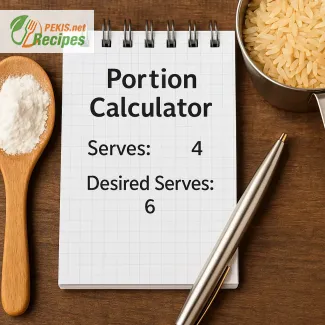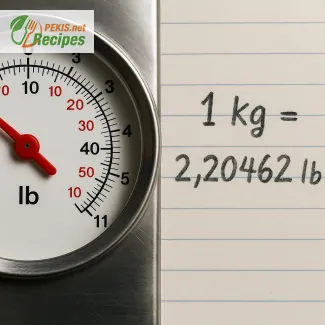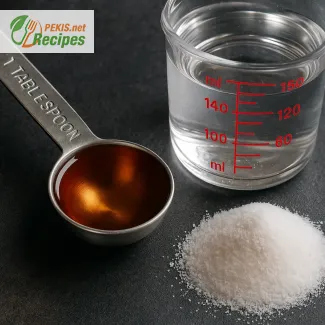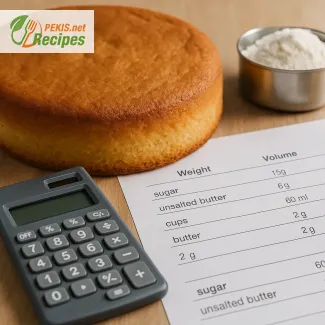
Mastering Recipe Scaling: Your Guide to Perfect Portion Adjustments
Discover how to adapt any recipe for any number of servings without hassle
Adjusting recipes for different portion sizes is a common kitchen challenge that cooks of all levels face. Whether you're planning a dinner party, cooking for two, or preparing meals ahead of time, the ability to scale ingredients up or down accurately is crucial. Our interactive portion calculator simplifies this process, helping you maintain flavor, texture, and consistency across any portion size. In this comprehensive guide, you'll learn how to scale recipes effectively, avoid common pitfalls, and become confident in adjusting servings—no matter the dish.
Interactive Portion Calculator
Adjusted Ingredients:
Why you need a recipe portion calculator
Scaling recipes manually can be tedious and error-prone. Most home cooks rely on rough estimates or mental math, which often leads to inconsistent results, especially in baking or precise cooking. A portion calculator for recipes ensures that:
- Ingredients are scaled with precision
- Cooking times are adjusted appropriately
- Nutritional information remains proportional
- No excess waste or shortages occur
By using a tool designed specifically for adjusting recipe portions, you save time and improve your cooking accuracy, especially when you're cooking larger batches or smaller servings.
When and how to scale your recipes
Scaling becomes essential in several scenarios:
Cooking for a larger group
Hosting a holiday dinner, party, or family gathering often means increasing portion sizes. With a portion calculator, you can multiply ingredients without losing balance in flavors or textures.
Reducing recipes for smaller servings
If you live alone or cook for two, full-size recipes may produce too many leftovers. A portion tool helps you reduce recipes without compromising results, especially in dishes like soups, sauces, or casseroles.
Prepping meals ahead of time
Meal prepping often involves creating multiple servings to store. Scaling a recipe in bulk ensures consistent quality in every container while optimizing your use of ingredients.
Adapting for dietary or budget purposes
Reducing portions can be useful when budgeting or following a specific dietary plan. Portioning tools make it easy to adapt your cooking to your needs without completely rewriting recipes.
How to use a portion calculator correctly
Using a portion calculator is straightforward. Here are the steps to follow:
- Enter the number of original servings the recipe is designed for.
- Input your desired number of servings.
- The calculator automatically adjusts ingredient quantities.
- For more advanced features, you can recalculate nutritional values, adjust cooking times, and even print out the new recipe.
Always double-check that ingredients requiring special attention—like baking powder, spices, or salt—are not over- or underrepresented. These ingredients may need slight manual adjustments to preserve flavor and texture.
Ingredients that require special consideration when scaling
Some ingredients don’t scale linearly, and understanding their behavior is key:
Seasonings and spices
Scaling these one-to-one can lead to overpowering flavors. It’s best to start with a slightly reduced amount and taste as you go.
Leavening agents
Ingredients like baking powder or yeast have a direct effect on rise and texture. When adjusting baked goods, always check the proportions relative to flour.
Eggs
Scaling whole eggs can be tricky. For example, halving an egg isn't precise. You might need to use egg substitutes or beat and divide eggs by volume for accuracy in smaller portions.
Liquid ratios
Stocks, broths, and sauces may need to be reduced longer or cooked shorter when portion sizes change. Always check for texture and consistency rather than relying on time alone.
Adjusting cooking times and temperatures
While ingredients may scale easily, cooking times often do not. Here's what to consider:
- Oven dishes: Doubling a casserole may not mean doubling the bake time. Monitor internal temperature and doneness cues instead.
- Roasting or baking: Thicker or larger portions need longer cooking, but temperature settings should remain the same.
- Stovetop recipes: Cooking larger quantities of soup or sauce may take more time to come to a boil, but simmering times can stay similar.
Use visual and tactile cues like bubbling, browning, or texture to decide when a dish is truly done.
How to preserve taste and texture when changing portions
Scaling a recipe is more than just math. Taste and texture must remain balanced, especially in complex dishes. Here’s how:
- Taste your dish at different stages of cooking.
- Don’t blindly trust ratios—adjust seasoning incrementally.
- Watch moisture levels. More servings may require a larger pan or different cooking vessel to maintain proper evaporation or searing.
In baked goods, structure and chemistry matter. If you're increasing a recipe by more than double, consider baking two separate batches to maintain consistency.
Best types of recipes to scale successfully
Some dishes are more flexible than others. These recipes scale particularly well:
- Soups and stews – forgiving and easy to double
- Curries and sauces – flavor improves with batch cooking
- Pasta bakes and casseroles – ideal for portioning into servings
- Marinated dishes – bulk prep enhances flavor depth
On the other hand, delicate pastries, meringues, or sponge cakes may not scale perfectly and should be approached with more care.
Common mistakes when adjusting recipes
Even with a calculator, it’s easy to fall into traps:
- Forgetting to scale all components, like toppings or garnishes
- Over-seasoning, especially with salt or strong spices
- Not adjusting cookware size, leading to under- or overcooked food
- Using the wrong scaling base – always check if the recipe is in grams or cups
Avoid these pitfalls by reviewing the recipe structure and ingredients before cooking.
Why consistency matters across servings
When cooking for events, family, or business, consistency is key. The same flavor, texture, and look in every serving builds trust and makes your meals more enjoyable.
If you’re meal prepping or offering food to others, uniform portions reflect professionalism and care. A portion calculator supports this effort with precision.
Digital vs. manual portion scaling
Using a portion calculator app or web tool is faster and more accurate than manual calculations. Benefits include:
- Real-time updates of quantities
- Integrated unit conversions (grams ↔ cups, ml ↔ tbsp)
- Custom serving size input
- Ability to print or save adapted recipes
Manual scaling, while educational, is more prone to human error—especially when recipes use mixed units or complex ratios.
How to convert measurements when scaling recipes
Recipes often mix metric and imperial units, especially in international dishes. A good portion calculator helps you handle:
- Volume to weight conversions (ml ↔ g)
- US to EU units (cups ↔ ml)
- Dry vs. liquid ingredients
Example: If a recipe calls for 500 g of flour and you want to make half, a calculator will automatically reduce it to 250 g and can also show in cups, depending on your region.
Meal planning made easier with accurate portions
Scaling recipes isn’t just useful for cooking—it’s a powerful tool for:
- Weekly meal plans
- Grocery shopping lists
- Budget-conscious cooking
If you cook regularly for families or clients, the ability to plan quantities precisely means less waste, fewer unexpected shortages, and more predictable nutrition.
How to batch cook and store scaled recipes
Batch cooking is a great way to save time during the week. Use the calculator to triple or quadruple recipes and follow these tips:
- Store meals in portion-sized containers for easy reheating
- Label with date and portion size
- Choose recipes that freeze well (soups, sauces, stews)
- Avoid scaling dishes with components that spoil quickly (e.g., fresh greens, raw eggs)
Tips for scaling recipes for special diets
Whether you're cooking for vegetarian, gluten-free, keto, or low-sodium diets, scaling recipes must be done carefully:
- Use the portion calculator to scale core ingredients, then manually adjust diet-specific substitutions.
- When scaling dairy-free or gluten-free recipes, watch for textural changes and adjust binders or liquids as needed.
- For low-sodium meals, avoid direct multiplication of salt quantities.
A calculator supports these adjustments, but dietary knowledge is crucial for accurate and safe outcomes.
Building your own custom recipe library with portion control
Once you start adjusting recipes often, it's helpful to save them in a personal library. You can:
- Keep original and scaled versions
- Record notes about cooking times and taste
- Tag recipes by portion size, season, or dietary preference
Digital tools allow exporting and storing these for quick access, helping you create a personalized meal system that evolves with your needs.
Kitchen confidence and scaling
Using a recipe portion calculator is more than just convenience—it’s a skill-building asset. It gives you control over your cooking outcomes, supports planning, and helps reduce food waste.
From family meals to professional catering, precise scaling is an essential technique that improves efficiency and confidence in the kitchen. By mastering this skill, you empower yourself to cook freely, creatively, and efficiently—no matter how many people you’re feeding.


